Remote Control Overhead Crane & Remote Control Gantry Cranes
Remote Overhead Crane for Sale
Remote overhead cranes, a cornerstone of industrial operations, have significantly evolved over the years, transitioning from manual to remote operations. These substantial advancements in crane technology have revolutionized the efficiency and safety measures within industrial settings.
The fundamental introduction to remote overhead cranes involves understanding their pivotal role in the industrial landscape. These cranes, also known as bridge cranes, feature a horizontal beam, or "bridge," running along elevated tracks, with a hoist and trolley mechanism for moving heavy loads horizontally and vertically. This design enables them to transport substantial materials within factories, warehouses, construction sites, and other industrial environments.
The evolution from manual to remote operations represents a quantum leap in crane technology. Initially operated by on-site crane operators through manual controls, these cranes have now adopted remote control mechanisms. This transition has vastly improved operational safety, efficiency, and precision in material handling processes.
The advent of remote control technology has marked a significant milestone in enhancing crane operations. Remote control offers crane operators the capability to manage the crane's movements and lifting operations from a safe distance, reducing the risks associated with on-site operations and providing a higher level of control over the equipment.
Exploring Different Types of Remote Overhead Cranes
Remote overhead cranes encompass a diverse array of crane types engineered to cater to various industrial lifting needs. These cranes are classified based on multiple factors such as their structural design, lifting mechanisms, below-hook devices, and intended industrial applications. Common types of remote overhead cranes include single girder cranes, double girder cranes, top running and under running cranes, wall-mounted cranes, semi goliath cranes, portable gantry cranes, and more. Each type offers distinct features, benefits, and applications tailored to specific lifting requirements in industries ranging from manufacturing, automotive, construction, logistics, and shipbuilding. These cranes are equipped with remote control technology, enhancing their efficiency, safety, and maneuverability in various industrial settings.
Remote Overhead Crane
Overhead remote cranes stand as a pinnacle of industrial lifting equipment, revolutionizing traditional material handling operations. These cranes, designed for various industrial applications, elevate efficiency, safety, and flexibility by integrating remote control technology into their functionality.
Overhead remote cranes are a class of lifting machinery equipped with cutting-edge remote control capabilities. These advanced systems allow operators to manipulate crane movements, load handling, and positioning from a safe distance, enhancing operational efficiency and safety within industrial settings.
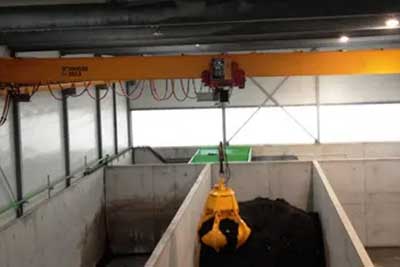
Single Girder Cranes
Features: Single bridge girder supporting the hoist and trolley, cost-effective.
Benefits: Cost efficiency, ideal for moderate lifting tasks.
Typical Applications: Workshops, warehouses, and manufacturing units.
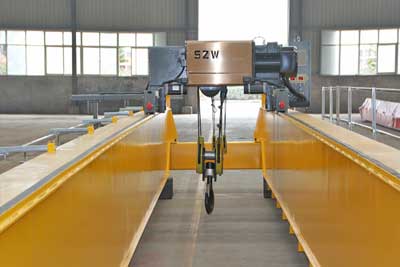
Double Girder Cranes
Features: Equipped with two girders for enhanced stability and higher lifting capacities.
Benefits: Increased stability, precision in heavy-duty lifting.
Typical Applications: Steel mills, foundries, shipyards.
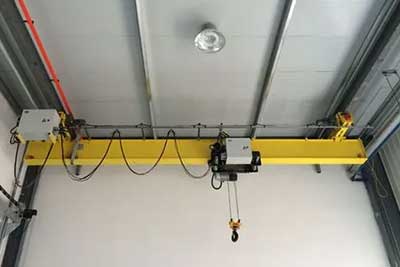
Under Running Cranes
Features: the under running crane travels beneath the crane runway.
Benefits: Under running for space-saving.
Typical Applications: The under running for limited space areas.
Key Features and Functionalities:
Remote Operation: A defining feature that enables operators to control the crane's movements, including hoisting, lowering, and traversing, using remote control devices.
Enhanced Safety: Remote control technology reduces the need for direct operator proximity to the load, minimizing potential risks and hazards associated with manual operation.
Efficiency and Precision: The precise control afforded by remote operation enhances load handling, offering increased accuracy and speed in material transportation.
Versatility: These cranes are adaptable to various work environments, allowing for flexible and efficient material handling across industries.
Overhead remote cranes find diverse applications across industries such as manufacturing, construction, logistics, warehouses, and more. Their ability to handle a wide range of loads, coupled with the flexibility and precision in operation, makes them indispensable tools in modern industrial settings.
With their ability to combine cutting-edge remote control technology and robust lifting capacities, overhead remote cranes stand at the forefront of industrial innovation, significantly enhancing productivity, safety, and operational efficiency in diverse work environments.
Remote jib cranes represent a pinnacle in material handling solutions, offering versatile and efficient lifting capabilities within a controlled workspace. These cranes, equipped with remote control technology, provide an optimal blend of maneuverability, precision, and safety, making them integral in various industrial operations.
Remote jib cranes, a subset of lifting equipment, feature a horizontal jib or boom assembly mounted onto a vertical mast. The distinguishing factor lies in their remote control capabilities, enabling operators to manage lifting operations from a distance. This innovation has redefined material handling processes by allowing for precision and flexibility in load manipulation.
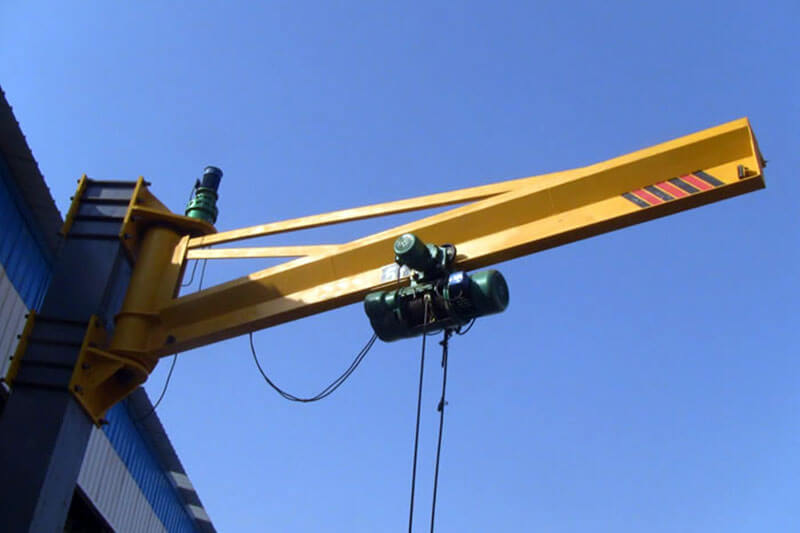
Wall-Mounted Remote Jib Crane:
Description: These jib cranes are affixed to a wall or column, providing a space-saving lifting solution.
Features: Fixed installation on a wall, offering 180 or 360-degree rotation for efficient load handling within a confined space.
Applications: Commonly used in smaller work areas, workshops, or production floors where floor space is limited.
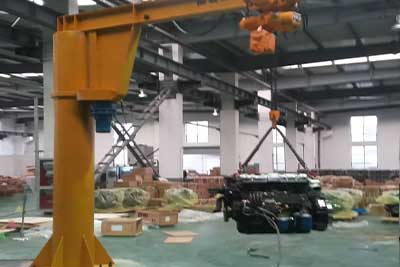
Floor-Mounted Remote Jib Crane:
Description: This type of jib crane stands on the floor and doesn't rely on a structure for support.
Features: Offers more mobility and flexibility in positioning compared to wall-mounted options.
Applications: Suitable for locations where wall or column mounting is impractical or not possible.
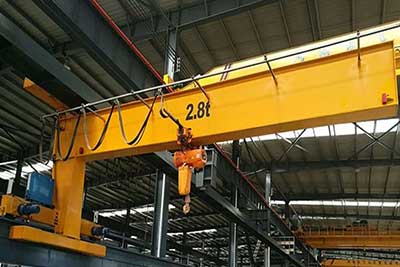
Wall-Traveling Remote Jib Crane:
Description: These cranes move horizontally along a wall-mounted track, combining the benefits of a wall-mounted crane with lateral movement.
Features: Allows the jib crane to travel along a fixed path on the wall, providing coverage across a larger area.
Applications: Commonly used in longer workspaces or facilities where a standard wall-mounted crane's reach is insufficient.
Each type of remote jib crane serves distinct purposes, offering advantages in terms of space utilization, mobility, and load handling. Selection depends on the specific requirements of the workspace, including available area, load capacities, and the need for mobility or lateral movement.
Key Features and Functionalities:
Remote Control Operation: Remote jib cranes are characterized by their ability to control lifting, lowering, and horizontal movement via remote devices or control panels.
Maneuverability: Their design facilitates easy movement of loads within a designated area, providing excellent reach and flexibility.
Safety Enhancements: Remote operation minimizes operator exposure to potentially hazardous environments, enhancing safety protocols.
Adaptability: These cranes are adaptable to various work settings, such as warehouses, workshops, and construction sites, due to their compact structure and efficient load-handling capabilities.
Remote jib cranes find applications across industries where lifting and handling of loads are routine. They are particularly useful in workshops, assembly lines, manufacturing units, and areas requiring localized lifting solutions. Their ability to efficiently handle moderate loads within a controlled space makes them an essential asset in industrial settings.
Remote jib cranes have transformed material handling operations by offering precision, safety, and versatility through remote control technology. Their ability to enhance workplace efficiency, minimize risks, and adapt to various environments makes them indispensable tools across multiple industries.
A Remote Control Gantry Crane represents a pivotal advancement in modern material handling technology, seamlessly merging the versatility of gantry cranes with the precision and convenience of remote control operation. This innovative system allows operators to manipulate crane movements from a distance, enhancing both safety and efficiency in various industrial settings.
Utilizing advanced wireless technologies, remote control gantry cranes have revolutionized the way heavy loads are lifted, transported, and positioned. These cranes are designed to cater to diverse industrial needs, offering flexible and precise handling solutions while reducing the need for manual intervention in material handling tasks.
Remote control gantry cranes are deployed across an array of industries such as manufacturing, construction, logistics, and more, proving instrumental in streamlining operations and optimizing productivity. Their adaptable nature and remote operation capabilities make them an indispensable asset in workplaces where precision, safety, and efficiency are paramount.
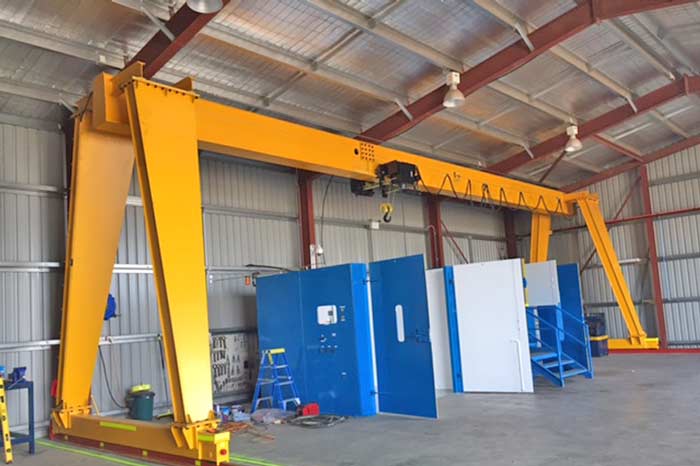
Remote Control Single Girder Gantry Crane:
Features:
Single girder configuration for efficient lifting and easy handling.
Well-suited for light to moderate load capacities.
Equipped with a wireless remote control system for seamless operations.
Typical Applications:
Used in warehouses, workshops, and smaller manufacturing units.
Ideal for handling loads within a moderate weight range.
Suitable for tasks requiring precision and flexibility in lifting.
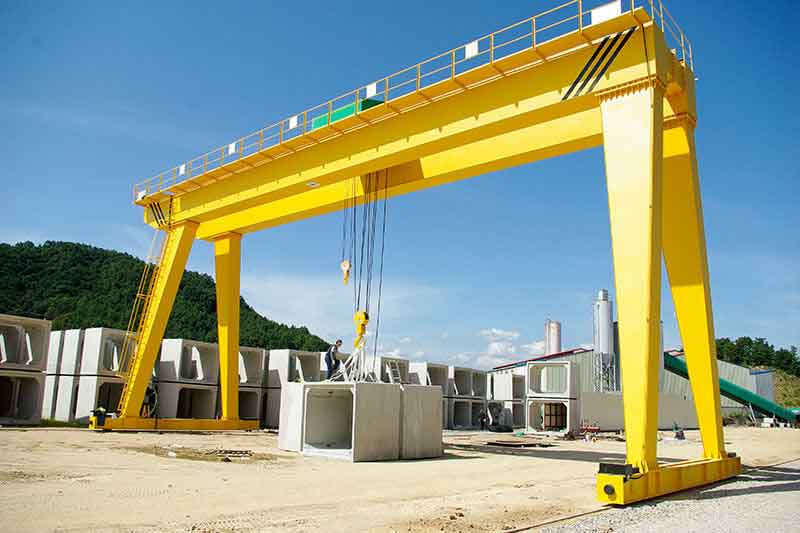
Remote Control Double Girder Gantry Crane:
Features:
Dual girder design for increased stability and higher lifting capacities.
Offers enhanced precision and efficiency in handling heavier loads.
Equipped with advanced wireless remote control technology.
Typical Applications:
Widely used in heavy-duty industries like steel mills, foundries, and shipyards.
Ideal for handling bulkier and heavier materials with precision.
Suited for tasks demanding high lifting capacities and stability.
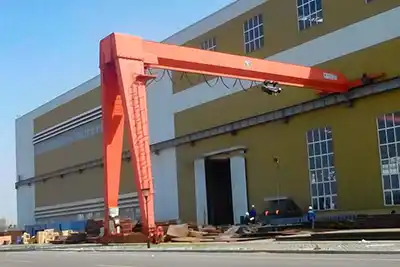
Remote Control Semi Gantry Crane:
Features:
One end travels on a runway while the other operates on the ground.
Combines the advantages of a gantry crane with partial mobility.
Integrated with a remote control system for enhanced maneuverability.
Typical Applications:
Commonly used in outdoor environments like loading docks, construction sites, or varied terrain.
Suited for handling loads in semi-outdoor environments with varying terrains.
Offers flexibility in movement and operation, especially in restricted spaces.
Based on Below Hook Devices:
Remote control cranes equipped with various below hook devices offer versatility and efficiency in material handling across diverse industrial settings. These cranes, integrated with specialized hoisting attachments, redefine lifting solutions and enhance operational capabilities. The integration of below hook devices optimizes the crane's functionality, allowing for the safe and efficient handling of specific load types. The diverse range of below hook devices, including magnets, clamps, vacuum pads, specialized grapples, and hoisting attachments, enables these cranes to handle a wide array of materials, from ferrous metals to irregularly shaped or delicate objects, catering to the unique requirements of different industries.
Remote Magnet Cranes
Features: Equipped with powerful magnets for lifting ferrous materials.
Benefits: Efficient handling of ferrous materials without slings or hooks.
Typical Applications: Scrap yards, metalworking industries.
Remote Clamp Cranes
Features: Fitted with clamps for gripping irregularly shaped objects.
Benefits: Secure grip for various non-standard materials.
Typical Applications: Industries handling pipes, beams, irregularly shaped materials.
Remote Vacuum Cranes
Features: Equipped with vacuum pads for handling non-ferrous, delicate materials.
Benefits: Securely holds fragile or non-metallic materials.
Typical Applications: Industries requiring gentle handling of delicate materials.
Remote Grapple Cranes
Features: Specialized grapple attachments for gripping specific materials.
Benefits: Efficient manipulation of specific materials.
Typical Applications: Forestry, bulk handling, waste management industries.
Other Below Hook Devices for Remote Control Cranes
Besides magnets, clamps, vacuum pads, and grapples, remote control cranes often utilize various other below-hook devices and specialized hoisting attachments tailored for specific load shapes, sizes, and material handling needs. These attachments are designed to accommodate a wide array of materials and streamline lifting operations. Here are some examples:
- Spreader Bars- Spreader bars are utilized to handle bulky or irregularly shaped loads. They consist of a horizontal beam with multiple attachment points for slings or hooks, allowing the crane to lift and balance loads evenly.
- C-Hooks- C-hooks are shaped like the letter "C" and are ideal for handling coils, rolls, or items with specific structural characteristics. They provide a secure grip and are commonly used in steel and metal industries.
- Lifting Beams- Lifting beams are structural members equipped with multiple attachment points and are suitable for lifting loads with multiple lifting points. They offer stability and balance when handling oddly shaped or long loads.
- Coil Hooks- Coil hooks are specifically designed to handle coils of steel, wire, or similar materials. They provide a secure attachment for lifting cylindrical loads and prevent slippage during lifting.
- Pallet Lifters- Pallet lifters are designed to handle palletized loads. They securely grip the pallets, allowing for efficient and safe lifting and transporting of goods commonly found in warehouse operations.
- Drum Lifters-Drum lifters are used to handle drums or barrels. They provide a secure grip around the circumference of the drum, facilitating the safe lifting and movement of liquid or solid materials stored in drums.
These specialized below-hook devices and hoisting attachments offer versatility and efficiency in material handling by adapting to various load shapes, sizes, and industry-specific requirements. They play a crucial role in enhancing the functionality of remote control cranes across a wide range of applications and industries.
Comparison of Remote Overhead Crane with Other Control Systems:
The comparison between remote overhead cranes and other control systems in the industrial lifting landscape is a pivotal consideration for businesses aiming to optimize their operations. These comparisons help highlight the distinct advantages and features offered by different control mechanisms, allowing industries to make informed decisions based on their specific needs.
The evolution of crane technology has introduced various control systems, each offering unique functionalities and advantages. Remote overhead cranes stand out among other control systems due to their remote operation capabilities, which grant operators enhanced flexibility and convenience. However, it's essential to contrast these systems to understand their specific attributes and suitability for diverse industrial environments.
Cabin-Controlled Cranes: Traditional cabin-controlled cranes are operated by an operator stationed within the crane cabin. These systems provide a direct view of the lifting operation but may have limited maneuverability and can be less ergonomic.
Radio-Controlled Cranes: Radio-controlled systems enable crane operation from a distance using a radio transmitter. Operators have increased flexibility, mobility, and visibility, allowing them to manage the crane from various vantage points within the operational area.
Wireless Remote-Controlled Cranes: Similar to radio-controlled cranes, wireless systems eliminate the need for physical connections between the operator and the crane, providing unrestricted movement and operational flexibility.
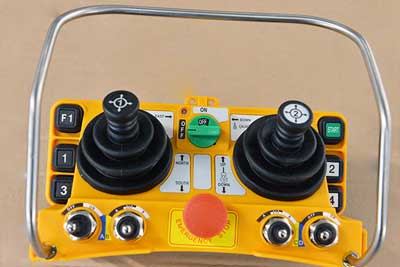
Remote Overhead Cranes:
These systems offer unparalleled versatility and convenience, allowing operators to control the crane remotely, optimizing safety and efficiency.
Features: Controlled wirelessly.
Benefits: Increased flexibility without tethering wires.
Typical Applications: Operations where wired connections are not practical.
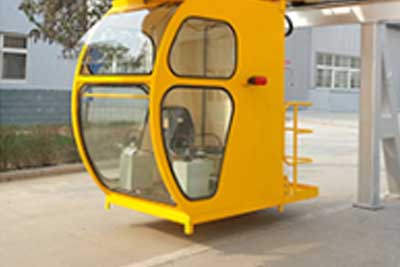
Cabin-Controlled Systems:
While offering direct operational control, they might limit visibility and flexibility compared to remote-controlled systems.
Features: Operated from within a cabin on the crane.
Benefits: Direct operator control and visibility.
Typical Applications: Situations requiring close proximity and visibility for control.
Radio-Controlled and Wireless Systems:
Both provide enhanced mobility and freedom of movement similar to remote overhead cranes but may differ in terms of signal stability and range.
Features: Controlled via radio frequency signals.
Benefits: Remote operation from a distance.
Typical Applications: Industries where remote control is essential but direct visibility is limited.
Factors such as operational requirements, safety concerns, maneuverability, and operational range play pivotal roles in determining the most suitable control system for a specific industrial setup. Understanding the unique features and benefits of each system helps industries make well-informed decisions to maximize productivity and safety in their lifting operations.
Typical Applications of Remote Overhead Cranes
Manufacturing Industry
Industrial Overview: The manufacturing sector heavily relies on remote overhead cranes for material handling, assembly, and movement of heavy components.
Types of Remote Control Crane Used: Single girder cranes, double girder cranes, and overhead gantry cranes are commonly employed in this sector.
Typical Functions and Application: These cranes facilitate the transfer of raw materials, machinery, and finished products across assembly lines, aiding in manufacturing processes and streamlining production operations.
Automotive Industry
Industrial Overview: Remote overhead cranes are crucial in the automotive sector for lifting and transporting heavy components during vehicle manufacturing.
Types of Remote Control Crane Used: Single and double girder cranes are widely utilized, along with specialized cranes designed for specific automotive tasks.
Typical Functions and Application: These cranes help in moving engines, car bodies, chassis, and other components along assembly lines, contributing to efficient vehicle production.
Construction Sites
Industrial Overview: Remote overhead cranes play a pivotal role in construction by assisting in lifting and placing heavy materials at construction sites.
Types of Remote Control Crane Used: Tower cranes, mobile cranes, and overhead cranes are used for various construction tasks.
Typical Functions and Application: These cranes aid in lifting steel beams, concrete panels, construction materials, and equipment, contributing to building construction and infrastructure development.
Warehousing and Logistics
Industrial Overview: Warehousing and logistics rely on remote overhead cranes for efficient movement and storage of goods and materials.
Types of Remote Control Crane Used: Overhead gantry cranes, jib cranes, and workstation cranes are commonly used in warehouse settings.
Typical Functions and Application: These cranes help in loading/unloading, stacking pallets, and moving heavy items within warehouses, enhancing logistics and material handling efficiency.
Shipbuilding Yards
Industrial Overview: Remote overhead cranes are indispensable in shipyards for handling heavy ship components and aiding in shipbuilding activities.
Types of Remote Control Crane Used: Large capacity gantry cranes and mobile cranes are commonly employed in shipbuilding.
Typical Functions and Application: These cranes assist in lifting ship components, assembling vessels, and transporting heavy loads within the shipyard, contributing to the construction and maintenance of ships.
Steel and Metal Industries
Industrial Overview: Remote overhead cranes are vital in steel and metal industries for handling heavy metal sheets, bars, and other materials.
Types of Remote Control Crane Used: Heavy-duty overhead cranes and specialized magnet-equipped cranes are utilized in these industries.
Typical Functions and Application: These cranes aid in lifting, transporting, and positioning heavy metal materials during various metalworking processes, enhancing efficiency in steel and metal manufacturing.
Heavy Equipment Manufacturing
Industrial Overview: Remote overhead cranes are pivotal in heavy equipment manufacturing for handling large machinery and components.
Types of Remote Control Crane Used: High-capacity double girder cranes and customized cranes are employed in heavy equipment manufacturing.
Typical Functions and Application: These cranes assist in lifting and assembling heavy industrial machinery, contributing to the manufacturing of large equipment and machinery components.
Specialized Remote Overhead Crane for Different Industrial Sectors
- Automotive Industry: Overhead cranes with precise control features and specialized lifting tools designed for handling vehicle components like engines, car bodies, and chassis with utmost accuracy and care.
- Construction Sector: Tower cranes equipped with remote control capabilities for lifting heavy construction materials to significant heights, aiding in skyscraper construction and other tall structure projects.
- Warehousing and Logistics: Automated overhead gantry cranes featuring remote control functionalities for efficient and automated handling of goods, enabling swift and precise material movements within warehouses and distribution centers.
- Shipbuilding Yards: Large capacity gantry cranes designed with remote control capabilities to handle heavy ship components and aid in assembling vessels, ensuring smooth operations within shipyards.
- Steel and Metal Industries: Magnet-equipped cranes with remote controls for handling heavy metal sheets, bars, and scrap metal materials efficiently, ensuring seamless operations in steel mills and metalworking plants.
- Heavy Equipment Manufacturing: Double girder overhead cranes with customized controls and lifting attachments suitable for handling heavy industrial machinery and equipment components during manufacturing processes.
Each specialized remote overhead crane configuration is meticulously designed to meet the unique needs and demands of specific industries, ensuring precision, safety, and efficiency in material handling and production operations.
Top Concerns of Users of Remote Overhead Cranes
Safety Measures:
Safety is a pivotal aspect governing the use of remote overhead cranes. Prioritizing safety protocols, including strict adherence to established safety standards, conducting regular equipment inspections, and integrating advanced safety features within the remote control systems, stands as a fundamental pillar to prevent accidents. These safety features might include emergency stop functions, collision avoidance systems, overload protection mechanisms, and other safety interlocks. Additionally, providing comprehensive training to crane operators on the usage of safety features and effective handling of emergency situations remains crucial.
Maintenance Challenges:
Effective and regular maintenance routines are critical for ensuring the efficient and safe operation of remote overhead cranes. Overcoming maintenance challenges involves establishing a structured maintenance schedule encompassing routine checks for components, gears, controls, and the entire system. Proactive maintenance strategies significantly contribute to identifying potential issues at their nascent stages, minimizing downtime, reducing overall repair costs, and ultimately extending the crane's operational lifespan. Regular lubrication, inspection of electrical components, and monitoring wear and tear are among the key aspects of efficient maintenance protocols.
Operator Training:
The proficiency of operators is paramount for the safe and effective operation of remote overhead cranes. Robust and comprehensive operator training programs play a pivotal role in ensuring optimal crane operation. These training programs cover various aspects such as crane functionality, remote control operation, adherence to safety guidelines, and comprehensive emergency procedures. Well-trained operators are equipped to handle the remote overhead cranes efficiently, minimizing the likelihood of accidents, ensuring workplace safety, and maximizing overall productivity.
Ensuring a holistic approach that includes a strong emphasis on safety measures, consistent maintenance routines, and comprehensive operator training significantly mitigates potential risks associated with remote overhead crane operations.
Addressing Common Questions and Answers about Remote Overhead Cranes
How does remote operation enhance crane performance and safety?
Remote operation significantly improves crane performance and safety by enabling operators to control the crane from a safe distance. It provides better visibility of the lifting area, enhancing precision and reducing the risk of accidents. Additionally, remote operation allows operators to respond quickly to changing conditions, improving overall efficiency and safety.
What are the key features to consider when choosing a remote overhead crane?
Several key features are crucial when selecting a remote overhead crane. These include the crane's lifting capacity, span, height, speed, control system, safety features, and compatibility with the specific requirements of the intended application. Moreover, considering the quality, reliability, and after-sales service of the manufacturer is essential.
How can one ensure optimal maintenance for remote-controlled cranes?
Ensuring optimal maintenance for remote-controlled cranes involves adhering strictly to the manufacturer's maintenance guidelines and schedules. Regular inspections, lubrication of moving parts, testing safety devices, and promptly addressing any identified issues are vital. Moreover, conducting routine checks on the remote control system, batteries, and communication signals is essential for seamless crane operation.
What are the typical industrial sectors that benefit most from remote overhead cranes?
Remote overhead cranes find extensive use in various industries. They are particularly beneficial in manufacturing, automotive, construction, warehousing, logistics, and shipbuilding industries. Their versatility, efficiency, and ability to handle heavy loads make them indispensable for material handling and lifting operations in these sectors.




